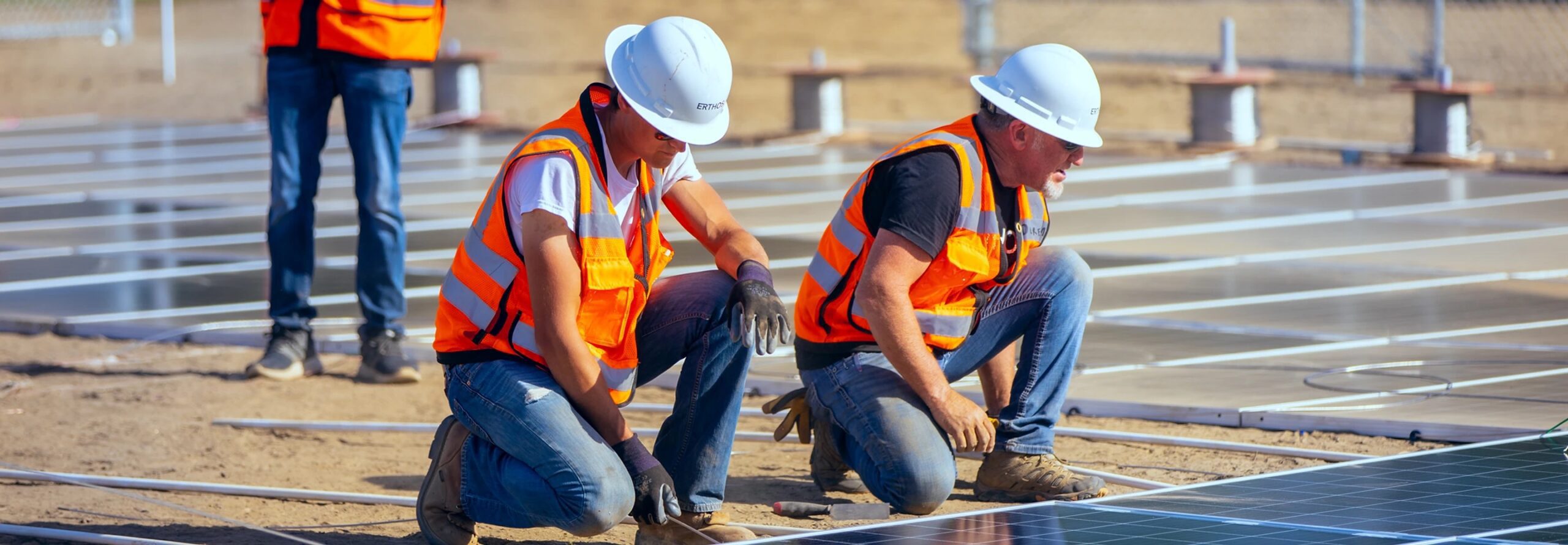Not only has solar energy expanded geographically over the past decade, with installations now in all 50 states, but the types of projects have also gotten more innovative. Enter Arizona-based Erthos, Inc., a company that installs photovoltaic solar modules on the ground with its Earth Mount Solar™ PV platform.
As CEO Jim Tyler, previously a vice president at First Solar, explains, “by simply putting the solar modules on the ground, we eliminate the most costly, complex, and risky elements in the construction of solar power plants. And we do this while achieving the same or better AC energy production.”
As Tyler hints, Erthos sees numerous benefits from its deployment strategy. Installing panels on the ground eliminates the need for trackers or racking that could keep them suspended in the air. The move eliminates a lot of unnecessary materials, including all the steel needed and 70% of cables and water. It simplifies the installation process, consisting of “only light civil engineering” and requiring half the time of a traditional project.
Elimination of trackers and racking saves a lot of money, a huge achievement considering that solar costs have already declined 82% over the past 10 years.
In a 100-megawatt project in the U.S., Erthos’ process eliminates the $0.15 per watt attributable to racking. Daniel Flanigan, chief marketing and product officer, notes that the company sees “our technology as a mitigator of risk around the cost of steel,” which has recently risen rapidly. There is also no cost for digging due to 70% less underground trenching.
Ion Yadigaroglu, a partner at Capricorn Investment Group, who led Erthos’ $17.5 million Series B round in March, believes the company can cut the installation costs of large-scale projects by one-fifth.
“I can say with a straight face that Erthos may be the single largest contributor to decarbonization that we’re involved with over the next decade,” Yadigaroglu said. “There are very few opportunities to make 20% improvements in the cost-effectiveness of solar.”
Erthos’ method also eliminates a lot of risks. “Since you’re not driving piles into the ground, you have no subsurface risk — what’s happening under the array is inconsequential,” Flanigan said. It also eliminates risk from above the surface: laying flat makes the installations hurricane-resistant. CPP Wind Engineering Consultants gave the system a wind rating of 194 miles per hour. In the case of flooding, the glass and connectors would be able to continue operating while submerged.
It also minimizes space used and maximizes project capacity. Because the installation is one large sheet, as opposed to rows of elevated panels with gaps between them, each project uses one-third of the land area of a typical design. It also doubles the energy density and output per acre.
Earth Mount Solar PV usually needs less than 2.5 acres per megawatt, whereas conventional projects need five to six acres. A recently approved utility-scale project in Texas, in conjunction with Austin-based project developer Industrial Sun LLC, is the company’s biggest contract. However, it would not have been possible with other solar technologies due to land constraints.
Erthos has its hands in every step of this process. In addition to providing the development platform and acting as the solar architect, the company provides operations and maintenance over the project’s entire life. This service includes nightly robotic cleaning via an autonomous robot that rolls across the installation removing soiling. There is even a performance-based pricing guarantee, with fee reductions if the project does not perform up to par.
With the added benefits of a team with experience at Intel, First Solar, General Electric, Solar Frontier, and Tesla, among others, and $24.9 million in funding thus far, the future is bright for Erthos. “There’s no question that our business is continuing to accelerate,” said Charles Pimentel, chief commercial officer. “That’s in large part because of our ability to deliver improved energy density, higher wind ratings, and short build times — and to do so at a lower cost.”





